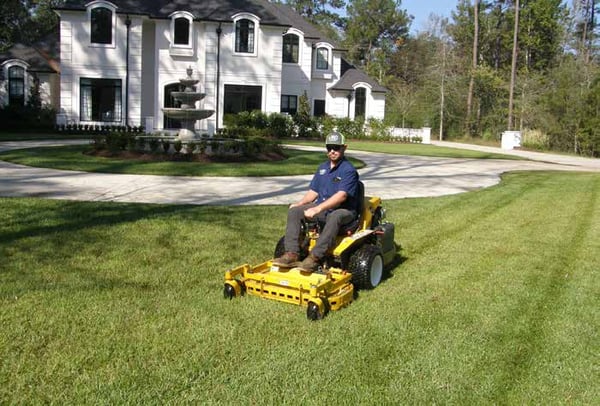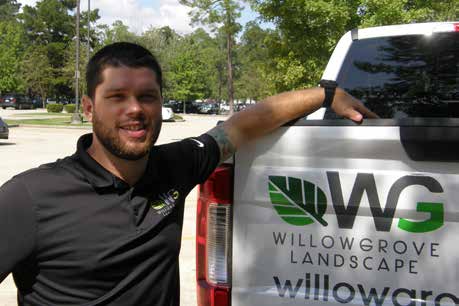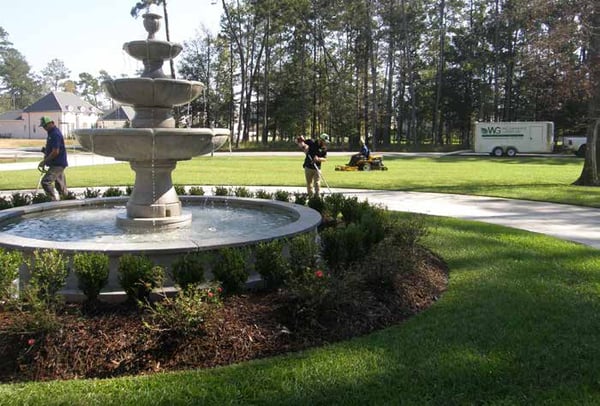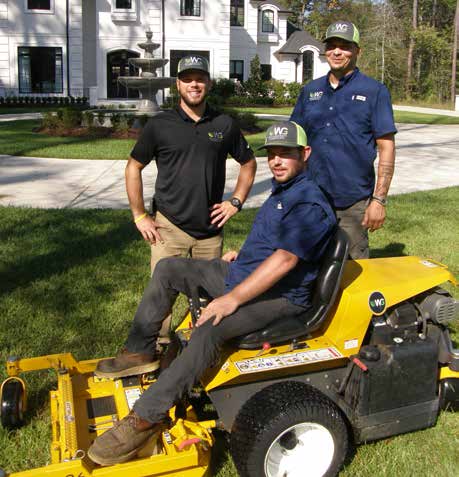 This Model B Walker Mower gets a workout three days a week. Once WillowGrove Landscape figures out the best way to handle clippings, its next one will have a GHS deck.
This Model B Walker Mower gets a workout three days a week. Once WillowGrove Landscape figures out the best way to handle clippings, its next one will have a GHS deck. Matt Knick, president of WillowGrove Landscape, spent several years in the industry prior to launching his company in March.
Matt Knick, president of WillowGrove Landscape, spent several years in the industry prior to launching his company in March.When Matt Knick launched WillowGrove Landscape in March, his savings account was in the red. He drained it to pay for living expenses, and to help finance a truck, enclosed trailer and a Model B Walker Mower. By fall, his newly formed company, located in Covington, Louisiana, was servicing 40 high-end residential and commercial properties. Already, the accounts generated more than $225,000 in sales and were well on the way to the $360,000 figure by year end. How does one go from zero to $360,000 in less than a year? In short, the owner relied on his experience, developed a game plan and had a strategy to execute it.
EXPERIENCE COUNTS
No, the young entrepreneur (he’s only 30 years old) didn’t wake up one morning and decide to maintain landscapes for a living. He spent several years learning the industry while working for large landscape contractors.
“I got my first taste of the industry by working for a homeowners association. The property manager hired me to work for a week, and the week extended to a month and then several months,” he recalls. He wasn’t getting paid much, about $12 an hour, but the initial experience opened doors for him. Knick eventually found work with a couple of landscape contractors, first as a laborer, then as a foreman and an account manager. At one point in his early career, he managed five mowing crews and later became a New Orleans branch manager for a Baton Rouge-based company.
 As WillowGrove Landscape grows, its owner, Matt Knick, expects to stick with efficient three-person crews.
As WillowGrove Landscape grows, its owner, Matt Knick, expects to stick with efficient three-person crews.“I enjoyed what I was doing, but something was missing,” says Knick. “I developed a passion for landscape design and installation, and wanted to do more of it. When a design and build company in Wisconsin offered me a position, I moved my young family north.”
The move was short-lived because the company’s fortunes turned south, leading Knick to interview with a few larger companies, including the likes of BrightView and LandCare. He nearly took a job with the latter in Naples, Florida. Instead, he decided to move back to where his father lived in Covington and start his own company.
“I took a chance,” he says. “I did some extensive research and hired Andrew Allgaier, founder of 75watts.com, to develop a website. The domain for the name I originally wanted for my company was already taken, so I changed the name and formed a limited liability company (LLC). My dad, Ron, is a builder and has several contacts in the area. That helped. My stepmother also pitched in by spreading the word. At first, I did a couple of cleanups and soon got my first maintenance account for $175 per month.”
Knick’s previous experience began to pay off quickly. He already knew how to budget, estimate his costs and price jobs. He had the right equipment for the job, too, including an enclosed trailer and a Walker Mower. “Two of the companies I worked for had Walker Mowers,” he notes. “I liked their cut, and they would be ideal for mowing the higher-end properties I wanted to target and maintain.”
GAME PLAN
Believing in the expression, don’t compete if you don’t have a competitive advantage, Knick wanted to bring something different to the table. “I didn’t want to just provide a service; I wanted to deliver real value to the customer,” he explains.
Launched a month before starting his company, the website details a game plan for providing “comprehensive design, installation and maintenance services.” The plan involves a five-step process for designing landscapes, e.g., hardscape elements, landscape lighting, planting trees and shrubs, water features and drainage systems.
 WillowGrove Landscape team members (left to right) include Matt Knick, Aaron Bovia and Thomas Seal.
WillowGrove Landscape team members (left to right) include Matt Knick, Aaron Bovia and Thomas Seal.The maintenance offering is equally comprehensive, and includes lawn care, flower bed maintenance, lawn fertilization, weed control, tree and shrub fertilization, insect and disease control, mulching and more.
Here again, previous experience paid dividends. Knick had the knowledge to provide the service offerings, along with the requisite horticulture and pest control licenses. But it wasn’t the breadth of services that set the new company apart from the competition, it was the owner’s approach to providing these services.
“Most homeowners are not very knowledgeable about landscapes and what it takes to make them look great,” according to Knick. “I think the key to providing exemplary service is understanding what the customers’ expectations are and explaining to them how a company plans to deliver on them. On the maintenance side, for example, it may take two or three months to bring new life to an existing landscape. The customer needs to know that and how you plan to get it done. I believe that educating customers, explaining what your company is doing, is critical to meeting and even exceeding their expectations.”
EXECUTION
Knick started with a couple of cleanups and that first $175-a-month account. His goal, though, was to set up new customers with annual full-service maintenance contracts that included weekly mowing instead of the biweekly mowing that most competitors offered. That amounts to anywhere between 38 and 52 mowing visits yearly, and it gives Knick an opportunity to stay ahead of any problems in the turf and beds, such as weeds, insects and diseases. By fall, nearly half of WillowGrove’s customers were on annual contracts, something that provided a steady revenue stream and income to sustain his highly skilled team members, Aaron Bovia and Thomas Seal.
Currently, revenue is generated equally between maintenance and installation services. His team does installations on Monday and Tuesday, and mowing and maintenance the rest of the week.
“My goal, especially in maintenance, is to be as efficient as possible. Experience tells me that smaller three-person crews are much more efficient than larger crews when factoring in window time and so forth,” Knick explains. Although he only has two current employees, that will change and, when it does, expect him to stay with smaller, more efficient crews.
In addition to the Walker Mower, the company has an Exmark for widearea and rough mowing, and a Toro walk-behind for catching clippings. Knick says his next Walker Mower will likely have a GHS deck, but he’s still deciding on how to handle clippings. He rents a skid-steer loader and other equipment required for installations as needed.
A 50- by 15-foot storage shed doubles as a workshop and warehouse. Knick’s wife, Lauren, helps run the business from home, keeping the books and answering the phone in between raising two (soon to be three) children.
If generating more than $300,000 the first year in business seems aggressive, imagine having a goal of $5 million in five years. Knick has the experience, game plan and execution to make it happen.




 Site Search
Site Search



